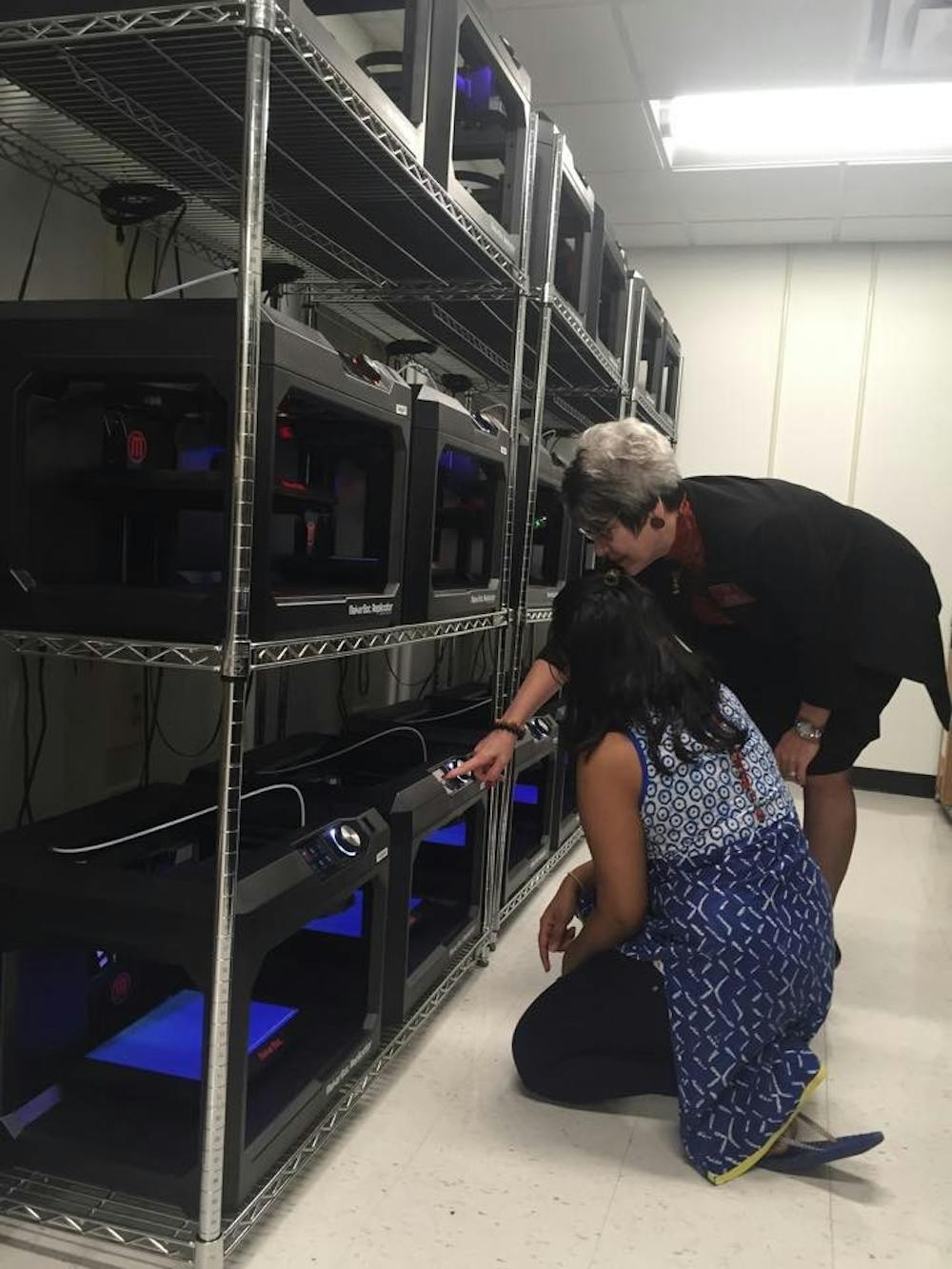Lab gives students access to 3D printers

The dean of the College of Education and Human Services, Dale-Elizabeth Pehrsson, examines a 3D printer in the MakerBot Innovation Center on Thursday, Oct. 20 in Wightman Room 143.
The robotic noise of 30 3D printers could be heard Thursday, Oct. 22 at the grand opening of the MakerBot Innovation Center.
“I’m very excited. This is an opportunity for students to completely rethink the way they develop garments and accessories for sale to fashion marketing,” said fashion merchandising and design professor, Michael Mamp, who teaches 3D Printing in Fashion (FMD 565).
Financial sponsorship and collaboration between the College of Communication and Fine Arts, the College of Education and Human Services and the Provost and President’s office supported the large-scale 3D printing operation located in Wightman Hall room 143. It cost about $350,000 with contributions from both colleges and offices.
“It was a neat collaboration between CCFA and EHS, and that doesn’t happen too often, or as often as it should," said Megan Goodwin, chair of human and environmental studies. "I think all of us realize that no one unit really has the resources to do some of the things we want to do, especially related to technology.”
Deans from the two colleges, faculty, staff and a few students were at the grand opening to introduce the new printers to campus. The new 3D printing center at Central Michigan University is the first of its kind in the Midwest, and one of the few in the U.S. to focus on the arts.
“This sort of tool is going to help students and faculty innovate faster and collaborate because it's not just going to be one or two departments (that use this) over time, this is only the beginning. It's going to grow,” said MakerBot account executive Mike Pritchard.
Free programs are available to use online to design 3D renderings that can be printed in the MakerBot Innovation Center that is available for public use within the university and community. Models can be created in 3D rendering programs and exported to the printing lab where users will be charged by gram of the piece they are printing.
“Collaboration across colleges will only be beneficial, it's just not easy to do," Goodwin said. "It takes a lot of planning and compromise on both sides."
Harbor Springs graduate student, Jennise Thurston, is majoring in apparel product development and merchandising technology, and got the opportunity to attend the MakerBot training workshop as the only student alongside faculty and staff in art in design and fashion merchandising.
Thurston has been heavily involved with developing fashion pieces on the printer, before the lab officially opened to the public and spent all semester creating a decorative fashion neckpiece.
“Merging engineering mind and artistic mind was the hardest struggle,” Thurston said.
She said despite how hard it was to learn the program for 3D printing, she was proud of how her piece turned out.
“It was fun watching it progress and see what the final product ended up being,” Thurston said.
In terms of fashion design, she said 3D printing is mostly being utilized for jewelry and accessories besides a few famous fashion designers who use 3D printing for clothing and art design.
“It’s getting there, it’s still on the starting edge, which is exciting to be a part of too,” Thurston said.
In the art and design program, a special course is being offered next semester that has curriculum based around the 3D innovation center. Art 397M Creation in 3D will be taught by art and design professor Greg Stahly.
“I teach ceramics, and when I take my students in the (3D) lab here, I have a feeling there will be plenty of interest in the course,” Stahley said.
He said the focus of the course will be on 3D modeling and printing, but the final project won’t always be straight off the printer. Utilizing the printer to make molds and combine them with other mediums is something Stahly will help students learn in his class.
“I don’t view the course I will be teaching as specifically an art course even,” Stahly said. “From apparel to engineering, there are so many things you can do with this.”
Stahly said he is one of the few faculty members who knows how to use the printers in the art and design program, because of a personal interest in 3D rendering and design. He started learning about 3D rendering about seven years ago and by watching video tutorials and reading books.
“I don’t think a whole lot of people know how to use it, (but) for me that’s my interest,” Stahly said.
He said it wouldn’t make sense for professors who are only using the printers for a few projects to know extensively how to use the lab, and as long as there were a few people in the department who had an understanding, they can help students use the 3D priners.
“We’re a little anxious about interest rising too quickly,” Dr. Goodwin said. “We want to make sure the purpose of the lab is to serve the university and the community, but we have to be able to manage that, so since its so new there are things we haven’t even thought of yet.”
Overall the grand opening was a positive event that showcased student work that had been done in the lab before the formal grand opening. It gave the colleges a chance to spread the word about the 3D printers and encourage people to use them throughout the college and community.



